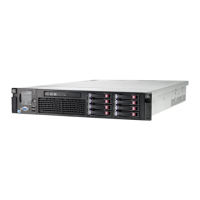In summary, special consideration should be given when choosing the MAC address-based
load-balancing algorithm in an environment where the server and clients are separated by a
Layer 3 device such as a router. In such an environment, the server must communicate with the
clients via the router (set as the server’s default gateway). When communicating with the clients,
the server sends all traffic to the router, which then sends the traffic to the clients. If MAC
address-based load balancing is selected, all traffic destined for clients is transmitted using the
same teamed port in the load balancing team and is not load balanced. This occurs because the
server must use the router’s MAC address as the Layer 2 address in every frame while it uses
the client’s IP address as the Layer 3 address in the same frame. Because the router’s MAC address
is used in every frame, the MAC address-based load-balancing algorithm chooses the same
teamed port for all transmitted traffic.
A better option is to choose the Automatic load-balancing algorithm described in the section,
“TLB Automatic Method”. The team’s transmit load balancing will be based on either the IP
address of the clients or the TCP ports for the connection rather than on the router’s MAC address
(which is the same for all connections through the router). In hybrid environments in which the
server is communicating with clients on its own network (Layer 2), as well as clients on the other
side of a router (Layer 3), HP recommends using Automatic method (refer to the section, “TLB
Automatic Method”), TCP Connection method (refer to the section, “TLB TCP Connection
Method”), or Destination IP Connection method (refer to the section, “TLB Destination IP Address
Method”).
TLB Round Robin Method for Outbound Load Balancing
Round Robin is a load-balancing method that will NOT preserve frame ordering. This method
is the simplest of all methods. It load balances every outbound frame out every operational
teamed port on a frame–by-frame basis. Absolutely no frame ordering is maintained. All teamed
66 The Mechanics of Teaming for the Advanced User

